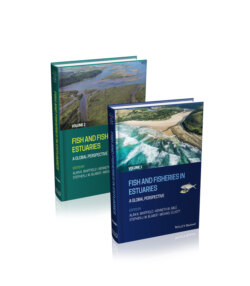Читать книгу Fish and Fisheries in Estuaries - Группа авторов - Страница 86
3.6.3 Anchoa mitchilli (Engraulidae)
ОглавлениеThe engraulid Anchoa mitchilli is believed to be the most abundant fish in coastal waters on the east coast of North America and the Gulf of Mexico (Able & Fahay 2010). The spawning behaviour and early‐life‐stage distributions indicate retention and production in estuaries, but A. mitchilli also occurs on the inner continental shelf (Able 2005, Able & Fahay 2010). Eggs and larvae occur ubiquitously in estuaries and coastal embayments but, in large estuaries such as Chesapeake Bay, are most abundant in seaward segments at salinities >10 (Rilling & Houde 1999, Auth 2003). Anchoa mitchilli matures at less than one year of age and <50 mm TL (Zastrow et al. 1991). Few recruited individuals (four to five months of age) survive to age 1 (Newberger & Houde 1995, Lapolla 2001). Accordingly, key recruitment processes are concentrated in early‐life stages. Rates of growth, mortality and biomass production in the larval stage are high and variable (Jung & Houde 2004b). Annual recruitments (age‐0, 30 mm TL) in Chesapeake Bay varied ninefold over a six‐year study period (Jung & Houde 2004a).
Preflexion larvae (<10 mm) utilise tidal dynamics or adopt other behaviours to migrate up‐estuary in tributaries of Chesapeake Bay and the Hudson Estuary (Loos & Perry 1991, Schultz et al. 2000, 2003, 2005a). Analysis in the Hudson River indicated active migration by larvae, but STST was not the probable behaviour (Schultz et al. 2005b). Instead, a combination of diel and tidally mediated behaviours were utilised to maintain location and facilitate migration. In contrast, Loos & Perry (1991) presented evidence that postflexion larvae did utilise STST to migrate up‐estuary in a tidal tributary of Chesapeake Bay. Applying otolith chemistry, Kimura et al. (2000) detected up‐estuary migration by >20 mm A. mitchilli larvae in Chesapeake Bay. That migration probably was facilitated by active swimming and accounted for a >4 km d−1 up‐estuary movement.
Mortality rates of Anchoa mitchilli eggs in Chesapeake Bay are high, averaging 0.066 hr−1 (Dorsey et al. 1996). At that rate, more than 73% of a daily cohort perished before hatching that occurs at 20 hour post‐fertilisation and 27 °C. At 48 hour post‐fertilisation, the average cumulative mortality of eggs and yolk‐sac larvae of a daily cohort was 92.5% (Dorsey et al. 1996). Such high loss rates of eggs may seem surprising. But survival of A. mitchilli at hatching (averaging 27%) is higher than estimated for the pleuronectid Pleuronectes platessa (19%), based on temperature and hatching success reported by Harding et al. (1978). Egg and yolk‐sac larvae mortality rates of A. mitchilli in Great South Bay, New York (Castro & Cowen 1991), and in Biscayne Bay, Florida (Leak & Houde 1987), were similar to those in Chesapeake Bay.
Growth and mortality of Anchoa mitchilli larvae are temporally and spatially variable and positively related to temperature and prey levels. In a five‐year study in Chesapeake Bay, mean growth rates ranged from 0.68 to 0.81 mm d−1 (Auth 2003), which were similar to those reported from other areas (Leak & Houde 1987, Castro & Cowen 1991, Rilling & Houde 1999, Jordan et al. 2000). Lapolla (2001) and Castro & Cowen (1991) noted that A. mitchilli larvae and small juveniles grew faster in high‐latitude bays and estuaries within the distributional range of this species, a possible expression of latitudinal compensation. Mortality rates of A. mitchilli larvae differed spatially within Chesapeake Bay and were higher in June (M = 0.41 d−1) than in July (M = 0.23 d−1), attributable to probable higher predation by jellyfishes in June (Rilling & Houde 1999). Averaged mortality rates of larvae in Biscayne Bay, Florida, were similar to Chesapeake Bay (Leak & Houde 1987), but rates in Great South Bay, New York (M > 0.50 d−1) (Castro & Cowen 1991), were higher. In Chesapeake Bay, mortality rates declined as larvae grew, without indication that mortality was density dependent (Rilling & Houde 1999).
